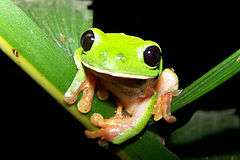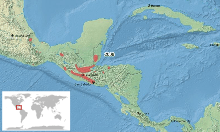Morelet's tree frog
| Morelet's tree frog | |
|---|---|
 | |
| Scientific classification | |
| Kingdom: | Animalia |
| Phylum: | Chordata |
| Class: | Amphibia |
| Order: | Anura |
| Family: | Hylidae |
| Genus: | Agalychnis |
| Species: | A. moreletii |
| Binomial name | |
| Agalychnis moreletii (Duméril, 1853) | |
 | |
| Synonyms | |
|
Hyla moreletii Duméril, 1853 | |
Morelet's tree frog (Agalychnis moreletii) is a species of tree frog of family Hylidae. It belongs to the leaf frog subfamily (Phyllomedusinae), and is found in Belize, El Salvador, Guatemala, Honduras, and Mexico. They have also been called black-eyed leaf frog and popeye hyla.
Its natural habitats are subtropical or tropical moist lowland forests, subtropical or tropical moist montane forests, freshwater marshes, and intermittent freshwater marshes. This frog is almost extinct due to habitat loss.
Description
This is a rare frog which has a green body, black eyes and a red or pink underbelly. They are found in moist subtropical lowland mountainous forests and wetland habitats of Belize, El Salvador, Guatemala, Honduras and Mexico. They have been collected on the Atlantic and Pacific slopes of Veracruz, Chiapas, the Maya mountains of Belize, northwestern Honduras and El Salvador. They can live in pristine or disturbed habitats and will breed in temporary or permanent bodies of water. They have an extended breeding season during the summer months. They deposit clutches of 50 to 75 eggs on vegetation or rocks over water. The eggs of the Morelet's tree frog have a green pigment and when they hatch, the larvae fall into the water to complete their development into frogs and it's also called as the black eyed tree frog.
Conservation
Morelet's tree frog was abundant within its range and were kept as pets internationally. However it is currently listed as critically endangered on the IUCN Red List as of 2001 because of habitat destruction and disease. Industry and agriculture are thought to be the main causes of lowland montane forest destruction. The population of Morelet's tree frogs are also being decimated due to a disease called Chytridiomycosis, which is an infectious disease that kills amphibians. Chytridiomycosis and habitat destruction are projected to cause the population to decline over 80% in the next 10 years. In some regions, the frogs have gone extinct completely. For example, a study done in 2004, has claimed that Morelet's tree frog may be extirpated from the region of Southern Mexico.[2] Small snakes also are predators of Morelet's tree frog.
Morelet's tree frogs are dying at a rapid rate. Their survival is dependent upon several factors due to their human and disease caused population decline. Some conservation measures are in place, while others are still in need of implementation or research. A number of protected parks have been created to curb habitat destruction in areas of Central America and Mexico. Taxonomic research is currently in place to further understand the population's status. More data is needed, however, on a temporal and spatial scale to determine trends in the population of Morelet's tree frogs.
References
- ↑ Georgina Santos-Barrera, Julian Lee, Manuel Acevedo, Larry David Wilson 2004. Agalychnis moreletii. In: IUCN 2012. IUCN Red List of Threatened Species. Version 2012.2.
- ↑ Lips, K. R., J. R. Mendelson 3rd, A. Muñoz-Alonso, L. Canseco-Márquez and D. G. Mulcahy (2004). "Amphibian population declines in montane southern Mexico: Resurveys of historical localities" (PDF). Biological Conservation. 119 (4): 555. doi:10.1016/j.biocon.2004.01.017.
Further reading
- Lee, J.C. 1996. The Amphibians and Reptiles of the Yucatán Peninsula. Cornell University Press. Ithaca, New York, USA.
- Duellman, W.E. 2001. The Hylid Frogs of Middle America. Society for the Study of Amphibians and Reptiles. Ithaca, New York, USA.
External links
| Wikimedia Commons has media related to Agalychnis moreletii. |
| Wikispecies has information related to: Agalychnis moreletii |
- http://fwie.fw.vt.edu/wcs/020310.HTM
- 2006 IUCN Red List of Threatened Species. Downloaded on 21 July 2007.
- Image of a Morelet's treefrog
